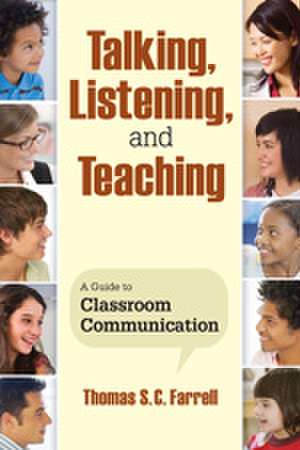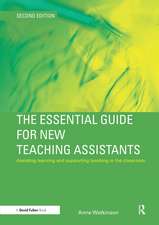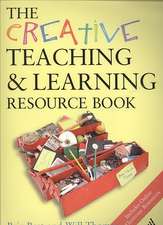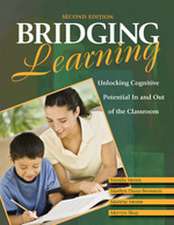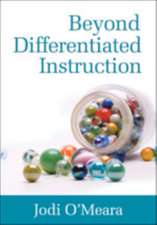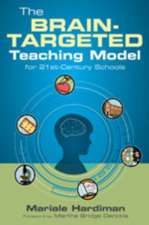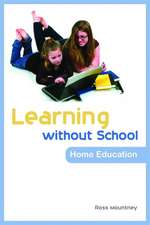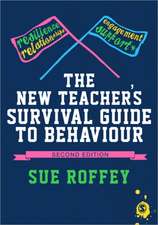Talking, Listening, and Teaching: A Guide to Classroom Communication
Editat de Thomas S. C. Farrellen Limba Engleză Paperback – 7 oct 2009
Talking, Listening, and Teaching demonstrates how important it is for teachers to understand and monitor classroom communication patterns and resolve problems that may hamper students' learning. Using examples from real classrooms, the author explains
- How classroom talk is different from communication outside the classroom
- How to gather and analyze data about classroom talk
- What type of questioning generates good discussions
- Why and how to give feedback to students
- How nonverbal communication impacts the classroom
This insightful guide to classroom communication, featuring provocative 'Thinking About Your Own Classroom' questions, is ideal for teacher study groups and benefits all educators who wish to effectively manage this important aspect of teaching and learning.
Preț: 200.74 lei
Nou
Puncte Express: 301
Preț estimativ în valută:
38.42€ • 41.71$ • 32.27£
38.42€ • 41.71$ • 32.27£
Carte tipărită la comandă
Livrare economică 22 aprilie-06 mai
Preluare comenzi: 021 569.72.76
Specificații
ISBN-13: 9781412962698
ISBN-10: 1412962692
Pagini: 120
Dimensiuni: 152 x 229 x 8 mm
Greutate: 0.2 kg
Ediția:New.
Editura: SAGE Publications
Colecția Corwin
Locul publicării:Thousand Oaks, United States
ISBN-10: 1412962692
Pagini: 120
Dimensiuni: 152 x 229 x 8 mm
Greutate: 0.2 kg
Ediția:New.
Editura: SAGE Publications
Colecția Corwin
Locul publicării:Thousand Oaks, United States
Recenzii
"This text speaks to an aspect of teaching that is often neglected in teacher preparation programs and in fact may not be on the radar of practicing teachers. As someone who designs and delivers professional development to practicing teachers, I can see a great deal of use for the ideas in this book. Experienced teachers often find that district-designed, one-size-fits-all PD is not particularly helpful, but this book has the potential to take each and every teacher from where they are right now and contribute to their professional growth."
"This book demystifies the verbal magic that helps teachers turn a classroom into a learning community with lively and engaging discourse. It provides teachers with the instructional elements necessary to orchestrate dialogue into a powerful learning tool. The book helps teachers empower students and give them an appropriate and potent voice in the teaching and learning environment."
"The author is clearly an experienced teacher who has taken an in-depth look at the topic of communication in the classroom."
"This book demystifies the verbal magic that helps teachers turn a classroom into a learning community with lively and engaging discourse. It provides teachers with the instructional elements necessary to orchestrate dialogue into a powerful learning tool. The book helps teachers empower students and give them an appropriate and potent voice in the teaching and learning environment."
"The author is clearly an experienced teacher who has taken an in-depth look at the topic of communication in the classroom."
Cuprins
Preface
Acknowledgments
About the Author
1. Talking, Listening, Teaching: Understanding Classroom Communication
Mary's Class: An Illustration
What Is Communication?
What Is Classroom Communication?
Talking and Listening
A Framework for Understanding Classroom Communication
Studying Communication Patterns
Reflecting on Classroom Communication
2. I Treat Them All the Same: Supporting Classroom Communicative Competence
"I Treat Them All the Same"
What Is Classroom Communicative and Interactional Competence
Home and School Communication Differences
Gender Differentiation
Communication Apprehension
Reflecting on Classroom Communicative Competence
3. You Talk Like a Teacher: Collecting and Analyzing Classroom Communication
Basic Classroom Communication Structure
Variability in Classroom Communication Structure
How to Examine Classroom Communication Patterns
Reflecting on Classroom Communication Data
4. Why Don't They Do What I Ask? Developing Effective Classroom Participation
A Bad Beginning
Organizing Effective Classroom Participation
Teacher Talk
Reflecting on Effective Classroom Participation
5. What Is 2+2? Examining Teachers' Questions
Informant Questioning Strategies
Types of Teacher Questions
Ways of Directing Questions
Characteristics of Good Teacher Questions
Characteristics of Unproductive Questions
Teacher Wait-Time
Reflecting on Teachers' Questions
6. OK! Good! Exploring Teacher Feedback
Purposes of Teacher Feedback
Teacher Feedback Strategies
Unproductive Teacher Feedback
Reflecting on Teacher Feedback
7. Two Heads Are Better Than One: Utilizing Learner Groupings
Turn Allocation in Whole-Class Grouping
Small Groups/Pairwork
Making Groups Work
Reflecting on Learner Groupings
8. I See What You're Saying: Recognizing Nonverbal Communication in the Classroom
Functions of Nonverbal Communication
Types of Nonverbal Communication
Teachers' Use of Nonverbal Behaviors in the Classroom
Reflecting on Nonverbal Communication
9. Professional Development: Reflecting on Classroom Communication and Interaction
Reflective Practice as Professional Development
Thinking About Your Own Classroom
Reflecting on Classroom Communication and Interaction
References
Index
Acknowledgments
About the Author
1. Talking, Listening, Teaching: Understanding Classroom Communication
Mary's Class: An Illustration
What Is Communication?
What Is Classroom Communication?
Talking and Listening
A Framework for Understanding Classroom Communication
Studying Communication Patterns
Reflecting on Classroom Communication
2. I Treat Them All the Same: Supporting Classroom Communicative Competence
"I Treat Them All the Same"
What Is Classroom Communicative and Interactional Competence
Home and School Communication Differences
Gender Differentiation
Communication Apprehension
Reflecting on Classroom Communicative Competence
3. You Talk Like a Teacher: Collecting and Analyzing Classroom Communication
Basic Classroom Communication Structure
Variability in Classroom Communication Structure
How to Examine Classroom Communication Patterns
Reflecting on Classroom Communication Data
4. Why Don't They Do What I Ask? Developing Effective Classroom Participation
A Bad Beginning
Organizing Effective Classroom Participation
Teacher Talk
Reflecting on Effective Classroom Participation
5. What Is 2+2? Examining Teachers' Questions
Informant Questioning Strategies
Types of Teacher Questions
Ways of Directing Questions
Characteristics of Good Teacher Questions
Characteristics of Unproductive Questions
Teacher Wait-Time
Reflecting on Teachers' Questions
6. OK! Good! Exploring Teacher Feedback
Purposes of Teacher Feedback
Teacher Feedback Strategies
Unproductive Teacher Feedback
Reflecting on Teacher Feedback
7. Two Heads Are Better Than One: Utilizing Learner Groupings
Turn Allocation in Whole-Class Grouping
Small Groups/Pairwork
Making Groups Work
Reflecting on Learner Groupings
8. I See What You're Saying: Recognizing Nonverbal Communication in the Classroom
Functions of Nonverbal Communication
Types of Nonverbal Communication
Teachers' Use of Nonverbal Behaviors in the Classroom
Reflecting on Nonverbal Communication
9. Professional Development: Reflecting on Classroom Communication and Interaction
Reflective Practice as Professional Development
Thinking About Your Own Classroom
Reflecting on Classroom Communication and Interaction
References
Index
Notă biografică
Thomas S. C. Farrell is a professor in applied linguistics at Brock University, Canada. He has been involved with ESL and applied linguistics for the past 27 years and has written extensively on topics such as reflective practice, language teacher development, and language teacher education. His recent books include Reflective Practice in Action (2004, Corwin Press), Reflecting on Classroom Communication in Asia (2004, Longman), and Professional Development for Language Teachers (2005, Cambridge University Press, coauthored with Jack Richards).
Descriere
This essential guide assists teachers of all grade levels and subjects to improve learning for every student in their classrooms.
